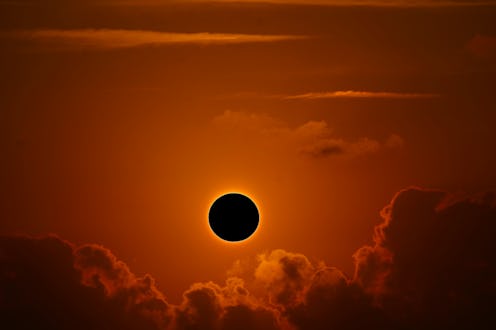Life
Read This If You're Nervous About Going Outside During An Eclipse
Not me being an adult who’s afraid of the dark…

The solar eclipse can easily seem like it's the end of world or something so rare you'd see it in a movie. However, on Monday, August 21, all of your nerdy solar dreams or folklore-infused fears will come true. There will be a total solar eclipse visible in the U.S. for the first time 1979, and that's a pretty big deal. If the sun being swallowed up by the moon's shadow or "umbra" makes you a little nervous, it's perfectly normal to wonder: is it safe to go outside during the solar eclipse?
Don't worry, everyone — total solar eclipses are actually fairly common, and happen every few years. This one only seems distinctive since the U.S. hasn't been in the path of totality of a solar eclipse for so long. But it will not wash the world in darkness forever and make us all miserable — it's perfectly safe to be outside while it happens. In fact, a lot of people are traveling to regions within the path of totality to do just that!
How long the darkness lasts or if you experience total darkness depends on your location. If you haven't already Googled if your location falls under the "path of totality" or where you will experience complete darkness, now is the time. According to space.com, totality is estimated to last between 40 seconds to two and a half plus minutes. Places such as Columbia, South Carolina or Hopkinsville, Kentucky will see this totality for at least 2.5 minutes, since they're the closest to the eclipse point.
Here's a map of the path of totality, which shows which regions will be able to experience this Monday's phenomenon as a total eclipse, and not just partial.
While it is safe to go outdoors to view the solar eclipse, it can damage your eyes if you aren't cautious. As a rule of thumb, you should always wear protective eyewear when viewing the sun. So during the eclipse, you should definitely plan to don a pair of eclipse-viewing glasses.
NASA said the following about why you should ditch those cute summer fun sunglasses this time around: "Homemade filters or ordinary sunglasses, even very dark ones, are not safe for looking at the sun; they transmit thousands of times too much sunlight."
If you are one of the lucky people whose area will experience totality, you are free to remove your glasses to enjoy the sight — but only while the sun is completely blocked. After it shifts into a partial eclipse, the glasses have to go back on. Aside from the few areas located closest to the eclipse point, be prepared to wear those protective glasses the entire time. Again, make sure it's safe before leaving your glasses at home.
If you have no idea how to get a hold of eclipse-viewing glasses in time for the big show, there is still a way to protect your peepers and experience the magic. NASA advises that an alternative method for viewing a partial eclipse can easily be done with your hands called pinhole projection. By stretching out your hands, placing one hand over the other, you can peer through the spaces created by your hands and allowing only small amounts of sunlight. You can also try recreate pinhole projection by punching a hole in an index card or cardboard. YouTube can be your best ally at this point!
With that said, don't be afraid to venture outdoors for the solar eclipse. Movies and folklore scare us into thinking the apocalypse is approaching if something like this happens. But this isn't the universe telling you that maybe it's time to find a new planet to inhabit. In fact, this might just be the time you find a reason to get the gang together and find a rooftop. Enjoy!